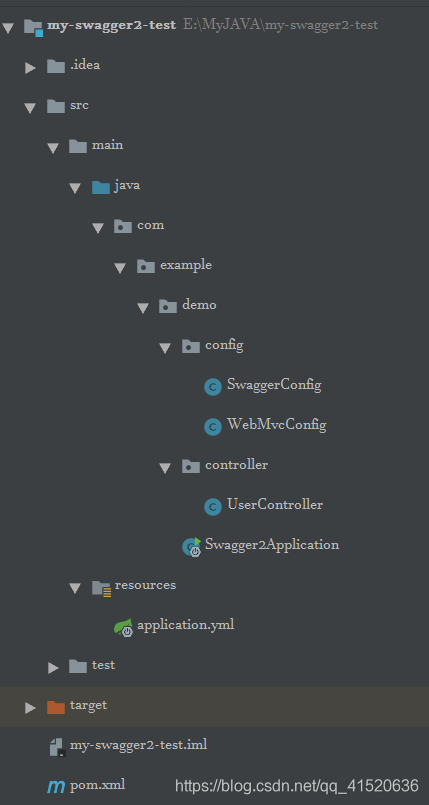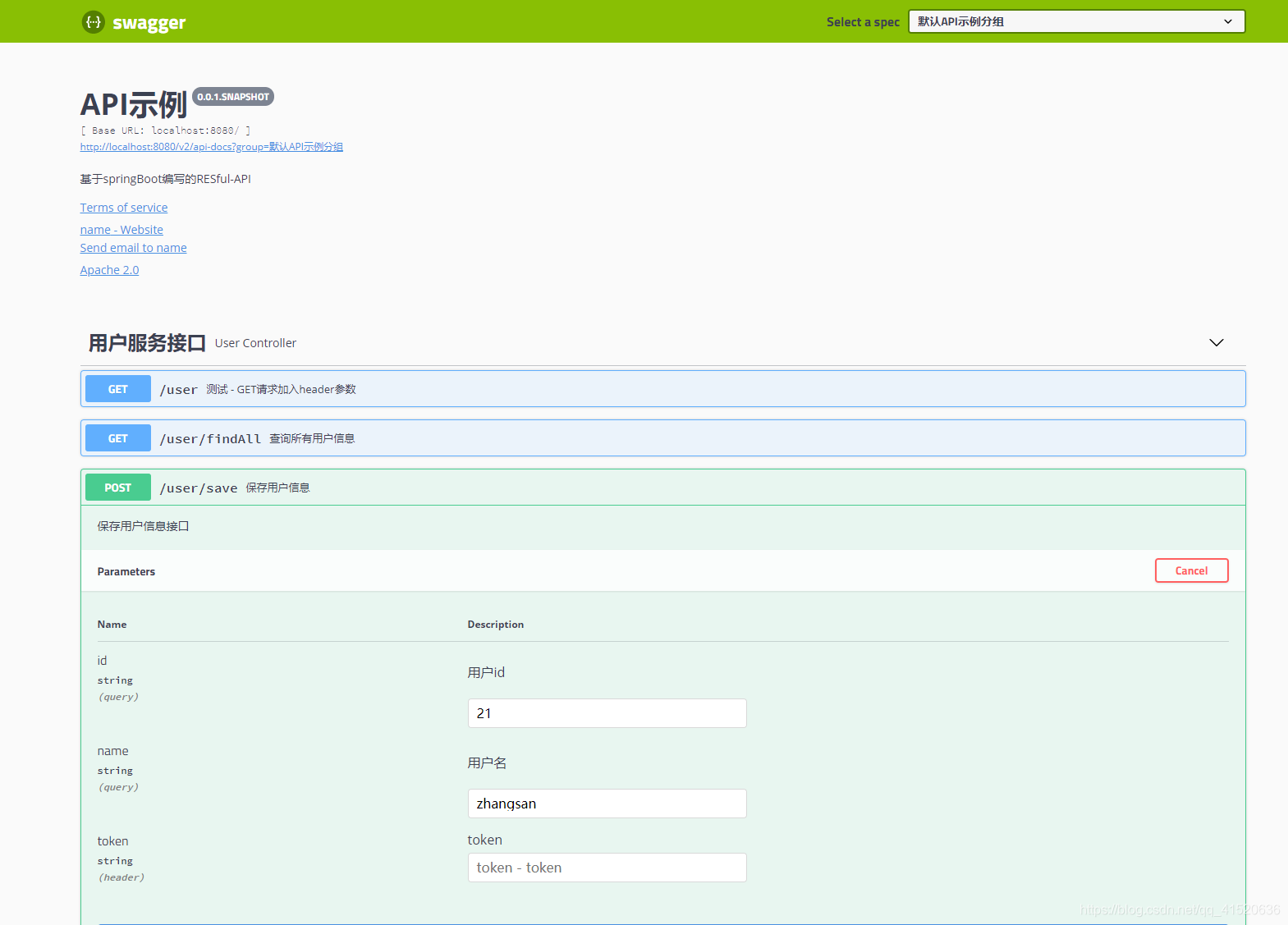1 介绍
swagger和市面上的禅道、RAP2等众多图形化接口文档非常类似,经过短时间的摸索,和大量的查阅各类博客,记录下swagger2的使用和理解。
pom角度上讲,springfox-swagger2-ui集成了前端页面,并且不需要我们去管理,并且还可以使用yml预先编写接口,然后在按照HTML页面上进行开发。
2 前言
个人学习了一个技术,就会进行记录,所以这篇博客也是学习多篇博客,复制出来的内容。没有什么好写,直接放代码。
2.1 pom
<?xml version="1.0" encoding="UTF-8"?><project xmlns="http://maven.apache.org/POM/4.0.0"xmlns:xsi="http://www.w3.org/2001/XMLSchema-instance"xsi:schemaLocation="http://maven.apache.org/POM/4.0.0 http://maven.apache.org/xsd/maven-4.0.0.xsd"><modelVersion>4.0.0</modelVersion><groupId>com.hikktn</groupId><artifactId>my-swagger2-test</artifactId><version>1.0-SNAPSHOT</version><parent><groupId>org.springframework.boot</groupId><artifactId>spring-boot-starter-parent</artifactId><version>2.1.4.RELEASE</version></parent><dependencies><dependency><groupId>io.springfox</groupId><artifactId>springfox-swagger2</artifactId><version>2.9.2</version></dependency><dependency><groupId>io.springfox</groupId><artifactId>springfox-swagger-ui</artifactId><version>2.9.2</version></dependency><!--fastjson--><dependency><groupId>com.alibaba</groupId><artifactId>fastjson</artifactId><version>1.2.51</version></dependency><!--测试包--><dependency><groupId>org.springframework.boot</groupId><artifactId>spring-boot-starter-test</artifactId></dependency><dependency><groupId>org.springframework.boot</groupId><artifactId>spring-boot-starter-web</artifactId></dependency><!-- 文件处理器--><dependency><groupId>org.springframework.boot</groupId><artifactId>spring-boot-configuration-processor</artifactId><optional>true</optional></dependency></dependencies></project>
2.2 application.yml
#swagger 配置swagger:title: API示例desc: 基于springBoot编写的RESful-APIversion: 0.0.1.SNAPSHOTtermsOfServiceUrl: javascript:void(0)license: Apache 2.0licenseUrl: http://www.apache.org/licenses/LICENSE-2.0.html# 监听的包路径basePackage: com.hikktn.controllergroupName: 默认API示例分组contactName: namecontactUrl: urlcontactEmail: email#生产环境改为false(改为false后swagger-ui.html则无法访问)enable: true#解决Swagger2 异常 NumberFormatException:For input string:""logging:level:io:swagger:models:parameters:AbstractSerializableParameter: ERRORserver:port: 8080servlet:context-path: /
2.3 Swagger2Application
package com.hikktn;import org.springframework.boot.SpringApplication;import org.springframework.boot.autoconfigure.SpringBootApplication;/*** @ClassName Swagger2Application* @Description 启动类* @Author lisonglin* @Date 2021/5/21 23:47* @Version 1.0*/@SpringBootApplicationpublic class Swagger2Application {public static void main(String[] args){SpringApplication.run(Swagger2Application.class,args);}}
2.4 SwaggerConfig
package com.hikktn.config;import io.swagger.annotations.ApiOperation;import org.springframework.boot.autoconfigure.condition.ConditionalOnProperty;import org.springframework.boot.context.properties.ConfigurationProperties;import org.springframework.context.annotation.Bean;import org.springframework.context.annotation.Configuration;import org.springframework.http.ResponseEntity;import org.springframework.web.bind.annotation.RequestMethod;import org.springframework.web.servlet.config.annotation.EnableWebMvc;import springfox.documentation.builders.*;import springfox.documentation.schema.ModelRef;import springfox.documentation.service.ApiInfo;import springfox.documentation.service.Contact;import springfox.documentation.service.Parameter;import springfox.documentation.service.ResponseMessage;import springfox.documentation.spi.DocumentationType;import springfox.documentation.spring.web.plugins.Docket;import springfox.documentation.swagger2.annotations.EnableSwagger2;import java.time.LocalDate;import java.util.ArrayList;import java.util.List;@Configuration@EnableSwagger2@EnableWebMvc@ConfigurationProperties(prefix = "swagger")/*** 生产环境禁用swagger2*/@ConditionalOnProperty(name = "swagger.enable", havingValue = "true")/*** @ClassName SwaggerConfig* @Description swagger2配置* @Author lisonglin* @Date 2021/5/21 23:38* @Version 1.0*/public class SwaggerConfig {private String title;private String desc;private String version;private String termsOfServiceUrl;private String license;private String licenseUrl;private String basePackage;private String groupName;private String contactName;private String contactUrl;private String contactEmail;/*** 增加API相关信息:包含作者、简介、版本、host、服务URL* @return*/private ApiInfo apiInfo() {return new ApiInfoBuilder()//接口文档的标题.title(title)//文档描述.description(desc)//版本号.version(version)//服务条款URL.termsOfServiceUrl(termsOfServiceUrl).licenseUrl(licenseUrl)//license 规范.license(license)// 开发文档的作者信息.contact(new Contact(contactName, contactUrl, contactEmail)).build();}@Beanpublic Docket swaggerApi() {// ==================== 需要的参数 START ====================List<Parameter> pars = new ArrayList<>();ParameterBuilder token = new ParameterBuilder();token.name("token").description("token").modelRef(new ModelRef("string")).parameterType("header").required(false).build();pars.add(token.build());// ==================== 需要的参数 END ====================return new Docket(DocumentationType.SWAGGER_2).apiInfo(apiInfo()).groupName(groupName).directModelSubstitute(LocalDate.class, String.class).genericModelSubstitutes(ResponseEntity.class).useDefaultResponseMessages(false).globalResponseMessage(RequestMethod.POST, customerResponseMessage()).globalResponseMessage(RequestMethod.GET, customerResponseMessage()).forCodeGeneration(true).select()// api包扫描.apis(RequestHandlerSelectors.basePackage(basePackage))// 设置选择器.apis(RequestHandlerSelectors.withMethodAnnotation(ApiOperation.class)).paths(PathSelectors.any()).build().globalOperationParameters(pars);}private List<ResponseMessage> customerResponseMessage() {List<ResponseMessage> list = new ArrayList<>();list.add(new ResponseMessageBuilder().code(200).message("请求成功").build());list.add(new ResponseMessageBuilder().code(201).message("资源创建成功").build());list.add(new ResponseMessageBuilder().code(204).message("服务器成功处理了请求,但不需要返回任何实体内容").build());list.add(new ResponseMessageBuilder().code(400).message("请求失败,具体查看返回业务状态码与对应消息").build());list.add(new ResponseMessageBuilder().code(401).message("请求失败,未经过身份认证").build());list.add(new ResponseMessageBuilder().code(405).message("请求方法不支持").build());list.add(new ResponseMessageBuilder().code(415).message("请求媒体类型不支持").build());list.add(new ResponseMessageBuilder().code(500).message("服务器遇到了一个未曾预料的状况,导致了它无法完成对请求的处理").build());list.add(new ResponseMessageBuilder().code(503).message("服务器当前无法处理请求,这个状况是临时的,并且将在一段时间以后恢复").build());return list;}public String getTitle() {return title;}public void setTitle(String title) {this.title = title;}public String getDesc() {return desc;}public void setDesc(String desc) {this.desc = desc;}public String getVersion() {return version;}public void setVersion(String version) {this.version = version;}public String getTermsOfServiceUrl() {return termsOfServiceUrl;}public void setTermsOfServiceUrl(String termsOfServiceUrl) {this.termsOfServiceUrl = termsOfServiceUrl;}public String getLicense() {return license;}public void setLicense(String license) {this.license = license;}public String getLicenseUrl() {return licenseUrl;}public void setLicenseUrl(String licenseUrl) {this.licenseUrl = licenseUrl;}public String getBasePackage() {return basePackage;}public void setBasePackage(String basePackage) {this.basePackage = basePackage;}public String getGroupName() {return groupName;}public void setGroupName(String groupName) {this.groupName = groupName;}public String getContactName() {return contactName;}public void setContactName(String contactName) {this.contactName = contactName;}public String getContactUrl() {return contactUrl;}public void setContactUrl(String contactUrl) {this.contactUrl = contactUrl;}public String getContactEmail() {return contactEmail;}public void setContactEmail(String contactEmail) {this.contactEmail = contactEmail;}}
2.5 WebMvcConfig
package com.hikktn.config;import org.springframework.context.annotation.Configuration;import org.springframework.web.servlet.config.annotation.CorsRegistry;import org.springframework.web.servlet.config.annotation.ResourceHandlerRegistry;import org.springframework.web.servlet.config.annotation.WebMvcConfigurer;/*** @ClassName WebMvcConfigurer* @Description 前后端分离项目跨域访问* @Author lisonglin* @Date 2021/5/22 1:30* @Version 1.0*/@Configurationpublic class WebMvcConfig implements WebMvcConfigurer {public WebMvcConfig() {}@Overridepublic void addCorsMappings(CorsRegistry registry) {registry.addMapping("/**").allowedOrigins(new String[]{"*"});}@Overridepublic void addResourceHandlers(ResourceHandlerRegistry registry) {registry.addResourceHandler("/**").addResourceLocations("classpath:/static/");registry.addResourceHandler("swagger-ui.html").addResourceLocations("classpath:/META-INF/resources/");registry.addResourceHandler("/webjars/**").addResourceLocations("classpath:/META-INF/resources/webjars/");}}
2.6 UserController
package com.hikktn.controller;import io.swagger.annotations.*;import org.springframework.http.ResponseEntity;import org.springframework.web.bind.annotation.*;import java.util.HashMap;import java.util.Map;/*** @ClassName UserController* @Description 用户服务控制器* @Author lisonglin* @Date 2021/5/21 23:39* @Version 1.0*/@RestController@RequestMapping("user")@Api(tags = "用户服务接口")public class UserController {@GetMapping("findAll")@ApiOperation(value = "查询所有用户信息", notes = "查询所有用户信息接口")public Map<String, Object> findAll() {Map<String, Object> map = new HashMap<>();map.put("success", "查询所有成功");map.put("state", true);return map;}@PostMapping("save")@ApiOperation(value = "保存用户信息", notes = "保存用户信息接口")@ApiImplicitParams({@ApiImplicitParam(name = "id", value = "用户id", dataType = "String", defaultValue = "21"),@ApiImplicitParam(name = "name", value = "用户名", dataType = "String", defaultValue = "zhangsan")})@ApiResponses({@ApiResponse(code = 404, message = "页面不存在"),@ApiResponse(code = 500, message = "服务器出错")})public Map<String, Object> sve(String id, String name) {Map<String, Object> map = new HashMap<>();map.put("success", "保存用户信息");map.put("state", true);return map;}@ApiOperation(value = "测试 - GET请求加入header参数")@ApiImplicitParams({@ApiImplicitParam(name = "token", value = "请求token", required = true, paramType = "header"),})@GetMappingpublic ResponseEntity<String> test(@RequestHeader String token) {return ResponseEntity.ok("token:" + token);}}
3 测试
http://localhost:8080/swagger-ui.html
4、Swagger注解总结
A.官方总结
Swagger相关注解官方说明地址
https://github.com/swagger-api/swagger-core/wiki/Annotations
B.常见总结
@Api()用于类
标识这个类是swagger的资源
tags–表示分组说明标签
@ApiOperation()用于方法
表示一个http请求的操作
value用于方法描述
notes用于提示内容
@ApiModel()用于实体类
表示对类进行说明,用于参数用实体类接收
value–表示对象名
description–描述
@ApiModelProperty()用于实体类字段
表示对model属性的说明或者数据操作更改
value–字段说明
name–重写属性名字
dataType–重写属性类型
required–是否必填
example–举例说明
hidden–隐藏
@ApiImplicitParam() 用于 controller 方法
表示单独的请求参数
name–参数ming
value–参数说明
dataType–数据类型
paramType–参数类型
example–举例说明
@ApiImplicitParams() 用于 controller 方法
@ApiIgnore()用于类或者方法上
可以不被swagger显示在页面上



